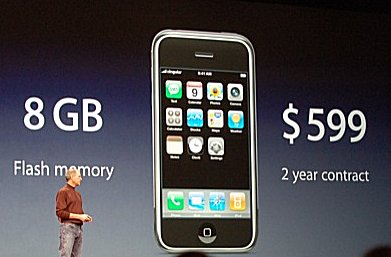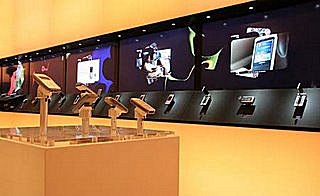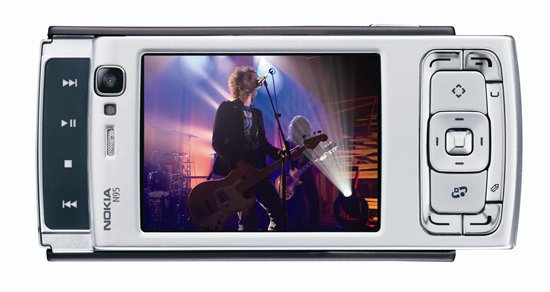Ewan's covering the iPhone 'phenomenon' (can't believe I just used the word, considering it's not even going to be available for the best part of a year) elsewhere on AAS today, from a Symbian, historical and satirical perspective, but I wanted to put into print my own thoughts on the positive aspects of the ultra-high profile iPhone launch by Apple.
 What Apple has done is 'break through', in my opinon.
What Apple has done is 'break through', in my opinon.
Not technically, don't misunderstand me. The multi-touch screen is all very clever and everybody's going to love that CoverFlow CD browser, but at the end of the day it's just another PDA phone with modest specs (no 3G, no HSDPA, mere 2 megapixel stills camera, no phone or music buttons, no or unknown extensibility with third party software) and a glitzy interface.
Where Apple has broken through, as they did with the iPod, is in introducing working hi-tech to the man and woman in the street. Before the white, ultra-stylish iPod there were MP3 players, of course. But they weren't terribly attractive, all had different interfaces and different PC/Mac connectivity suites of varying quality. The iconic white (at first) iPod came with simple and ubiquitous connectivity and the combination of looks and ease of use meant that they sold millions of the things. Apple had created a desire for their product that transcended the usual techy common sense - many competing MP3 players had higher specs and greater file compatibility but the iPod conquered all.
And now we have the iPhone, with similar self-proclaimed ease of use, both in its touch-screen interface and in the retention of the familiar iTunes for desktop connectivity. It will sell millions too, especially in the USA, its initial target market, but millions is a drop in the ocean when you're talking about smartphones. For example, Nokia sold getting on for thirty million S60-powered smartphones in 2006 and these sales are still increasing.
The breakthrough isn't then in terms of technical prowess or absolute sales, but in terms of getting the message to the general public that HEY, modern phones can play music, movies, send emails, browse the web, and so on. Despite Nokia's huge sales of S60 phones, the majority have been horribly undersold in that the purchasers have almost certainly not been conscious of the underlying S60 platform or of what the device they'd just bought in the high street could really do. The moment sellers start putting 'check email', etc. on the bullet point list in the shop, buyers would typically shy away, thinking that it's all going to be too difficult and complicated.
But with the launch of the iPhone, accompanied by massive and unprecedented media coverage on TV, radio and the Internet (of course), all that will hopefully change.
 Just as the iPod made MP3 players 'cool', accessible and genuinely understandable, awareness of the iPhone will help the entire smartphone industry emerge from its own geeky sphere, blinking, into the bright light of the mainstream, without having to constantly hide behind a self-imposed cloaking device. Suddenly, the likes of Nokia, Sony Ericsson, Samsung, etc. will be able to proudly point out all the things that their models already do that the iPhone is claimed to do (when released). Without fear of being seen as geeky anymore.
Just as the iPod made MP3 players 'cool', accessible and genuinely understandable, awareness of the iPhone will help the entire smartphone industry emerge from its own geeky sphere, blinking, into the bright light of the mainstream, without having to constantly hide behind a self-imposed cloaking device. Suddenly, the likes of Nokia, Sony Ericsson, Samsung, etc. will be able to proudly point out all the things that their models already do that the iPhone is claimed to do (when released). Without fear of being seen as geeky anymore.
Well, that's the theory anyway.
In practice, having watched the tightly scripted and planned iPhone demo in Steve Jobs' keynote, I was struck by the fact that many common operations did actually look more intuitive on his new device, however modest the specs and however many gotcha scenarios I can think up in my head.
Yes, I know that I could probably stage a similar 'blow people away' demo on the Nokia N93 (for example), and in fact I did this several times to friends and family over Christmas (moving from phone to PIM to DVD video recording to sat-nav to TV out, all within 2 minutes is enough to get even Apple fans on their seats!), but deep down I recognise that, despite the theoretical maturity of the S60 and UIQ interfaces, there are still usability issues that need to be tackled before any Symbian OS licensees can truly say to the man in the street, 'it's as easy to use as the iPhone'.
Of course, the presence of the multi-touch screen on the iPhone means that operations can be allowed which simply wouldn't be possible on S60 or UIQ (splaying two fingers apart on a map to zoom it in was one demo example that impressed me during the iPhone demo), whereas all S60 smartphones have (as a strength) robust, tough screens and a button-driven interface, while UIQ devices have traditional touch screens which only register a single tap at once.
But, hardware limitations apart, I'd like to see the back of some of the arcane nested dialogs in both interfaces (some settings need as many as seven taps or clicks to get to and I suspect only real tech-fans will ever get this far), a reduction/integration of the sheer number of 'proglets' shipped with S60, support for larger font sizes (I've lost count of the number of people who have said they couldn't use my smartphone because the text was too small) and real strides being made to make common operations and setup functions easier and easier.
Let's hope that at least some of the above improvements happen, to accomodate the expectations and abilities of the new prospective smartphone users that, thanks to the 'hype-over-substance' iPhone, are now well and truly in the market.
Steve Litchfield, 10 Jan 2007

